The Project
The Team
The Locations
Daily Journal
Contact Us
R/V Wecoma Daily Report
R/V Wecoma Cruise Track
Links
Glossary

|
Daily Journal
Vocabulary words to look for:
bar (noun)
The place where water from a bay or river empty into the ocean causing a build-up of sand and debris. A bar may be a narrow pile of rocks across the opening of a bay or river to prevent ocean swells from entering.
cast (verb)
Involves lowering instruments into the ocean to collect water samples.
rosette (noun)
A package or device used by oceanographers to collect sea water samples for their research; this consists of twelve cylinders positioned in a circle, held in place by a large round frame. The package also includes a light meter, flurometer (measures phytoplanktons in the water), and a CTD. See photo below.
CTD (Conductivity, Temperature, and Depth):
An instrument that is part of the rosette that is lowered into the ocean. As the name implies, this instrument measures the conuctivity and temperature of the water, and the depth of the unit.
sea legs (noun)
Having sea legs means you can walk about a moving ship as it is moving through the ocean. The ship pitches and rolls both forward and sideways making ordinary movements most challenging.
plankton (noun)
Aquatic organisms that drift with water movement; usually very small, there are two basic types of plankton. Both types of plankton make up a huge portion of the base of the ocean's food chain.
phytoplankton (noun)
Tiny plant-like organisms that drift in the ocean.
zooplankton (noun)
Tiny animals and animal-like organisms that drift in
the ocean;
bacteria (noun)
A group of single cell microorganisms, sometimes
beneficial and sometimes causing illness. |
September 13, 2004:
Aloha from the R/V Wecoma
FIRST DAY OUT
The R/V Wecoma is a 184.5 foot research vessel owned by NSF (National Science Foundation). This ship is used by OSU (Oregon State University) scientists to perform ocean and atmospheric research.
While still at the dock we saw pelicans, great blue herons, and a variety of other shore birds. At 10:00 a.m. Monday morning we set out for the open seas. The closer we got to the bar, the more the pitching and rolling increased.
Life at sea is physically demanding. Usually simple tasks like walking a few feet (without falling), pouring tea, ladling soup into a bowl, take on a whole new dimension on a moving ship. It's like an awkward, lurching dance. The crew all tell us that we'll get our sea legs soon and won't even notice the rolling. I find this hard to believe but meanwhile it's fun and challenging to stay upright. It feels like a giant rollercoaster where you have unlimited rides.
We will be at sea for 13 days. The purpose of the research is to study the effects of bacteria on phytoplankton. The scientists will be making periodic measurements of sea water by making a "cast" with a device called a Rosette (see the attached photo). The Rosette is lowered via a crane to almost the ocean floor which varies depending on location. The tubes are open on the descent, when the desired depth is reached, the tubes are closed to trap the ocean water inside. Closing the tubes is called "bottle firing."
Each time a cast is done, the downward and upward paths are monitored on a computer screen which graphs the amount of light in the water, phytoplankton in the water, oxygen, salinity (salt content), temperature, and pressure (as depth increases water pressure also increases).
Our first cast was at Latitude 44 degrees 45.10 minutes North, Longitude 124 degrees 30.16 minutes West. See if you can find us on a map of the Pacific Ocean. With these coordinates we were west of Newport, Oregon.
Here is a math problem for you to solve using averages. The last time this group of scientists went to sea, they were gone for four weeks, made 128 casts (to take measurements of ocean water). At this rate of casting, what was their average number of casts per day and per week.
At about the same rate of casting, determine how many casts we will make in the two week journey we are on now.
Photos below:
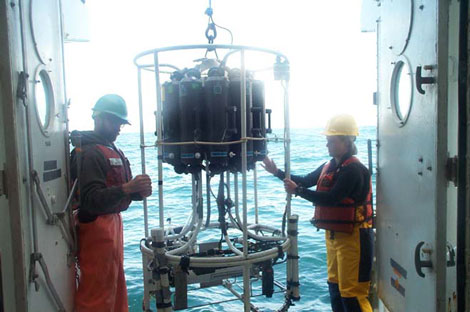
Daryl Swensen and Krista Longnecker lowering the Rosette into the ocean to take water samples.
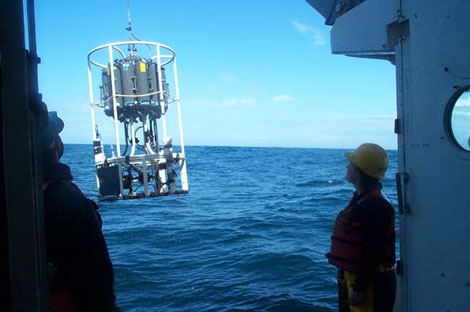
Retrieving the Rosette.
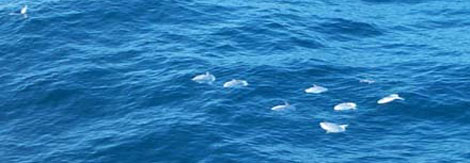
Our new friends, the Sunfish
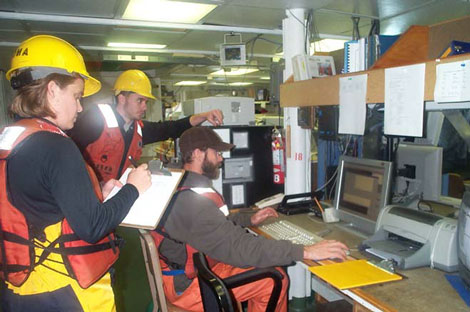
Krista Longnecker, EJ Etherington, and Daryl Swenson viewing data being sent from the Rosette while it is submerged in the ocean.
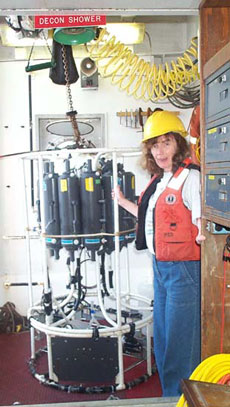
Annie deploying the CTD.

Deploying the CTD into the ocean.
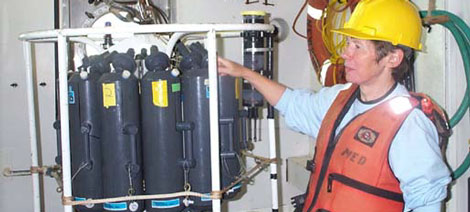
Susan deploying the CTD.
Back to Daily Journals

|







